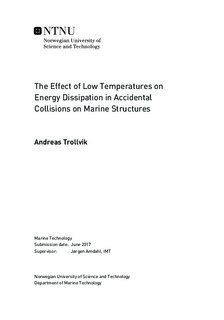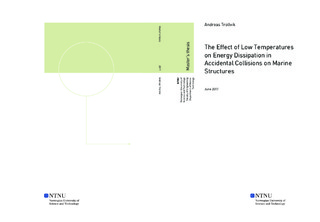| dc.description.abstract | The effect of low temperatures on impacts between ships and icebergs have been investigated. A material model developed by Woongshik Nam has been used for modelling the effect of brittle fracture. To test the model, an experimental study done by Kim et al (2016) has been replicated in Abaqus. After the impact study was replicated, an impact between the fore part of a DNVGL ICE-1A classed vessel and a circular ice body was simulated. As no material model for ice was found for Abaqus, the ice body was modelled as a rigid disc with a diameter of 10 meter and a thickness of 1.2 meter. The ship model was supplied by Suyu Wang and the Nam (2017) material model was used for the steel. The impact was simulated at a range of different temperatures, ranging from room temperature to -100°C. For the impact, the ice body was given an initial velocity of 0.5 m/s and had a mass of 1000 tonnes. Each simulation was run for 0.5 s.
The Kim et al (2016) study was an impact test of two panels, one stiffened and one unstiffened. These panels were impacted by a striker at two temperatures, room temperature and -60\degree C. In Abaqus the experiments were modelled with FEM by using both normal material parameters and the material code supplied by Woongshik Nam. The analysis showed that the Nam material model gave good results for the stiffened panel, compared to both the normal material and the experimental results. For the unstiffened panel, it was discovered that the bending stiffness of the two material codes was different. However, as the ship side is stiffened in both longitudinal and transverse direction, this should not influence the result.
The studies of the ship side showed a correlation between the temperature and the damage of the ship. As temperatures lowered, the damage of the ship side became more severe. With lower temperature, the collision energy was dissipated slower by the ship side. At the lowest temperature, -100°C, only 38\% of the total energy had been absorbed by the end of the simulation and the ship side had severe damage.
The failure criteria for temperatures between -60°C and -100°C has been interpolated from predefined failure criteria at -60° C, -100°C and -140°C. This leads to some uncertainties regarding the results at the intermediate temperatures. Some problems have been found with the ship side model. Two areas of the model have areas where elements from stiffener and bulkheads overlap, which creates some artificial stresses. In addition, some stress hot spots are created by the mesh. However, these areas are not close to the impact zone, and is not believed to have effected the results.
Overall, the results from the analysis displays the dangers of low temperatures in accidental impacts. The effect of the embrittlement of steel is reflected in the analysis, and should be taken into account when designing vessels for Arctic environments. However, further studies of the topic are needed before a clear conclusion can be drawn. | |

